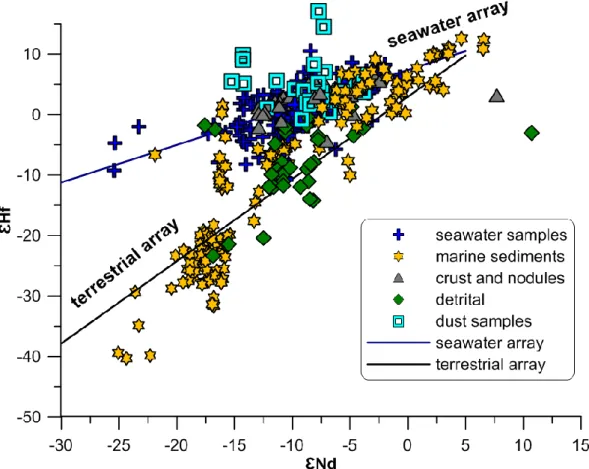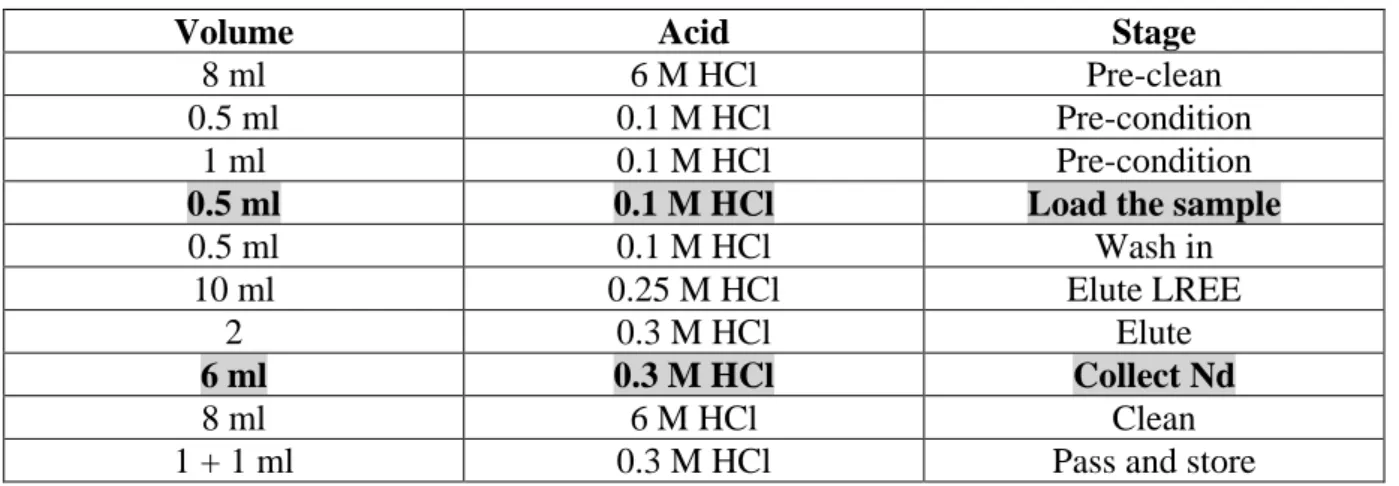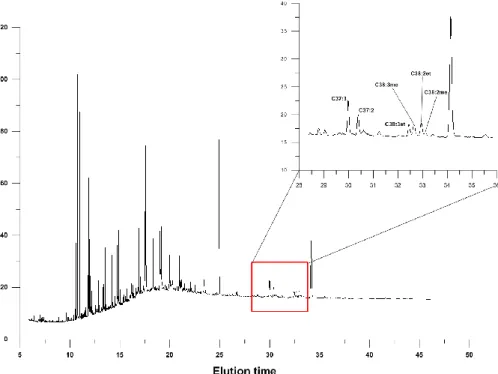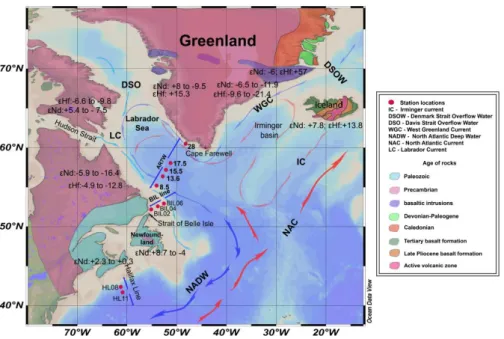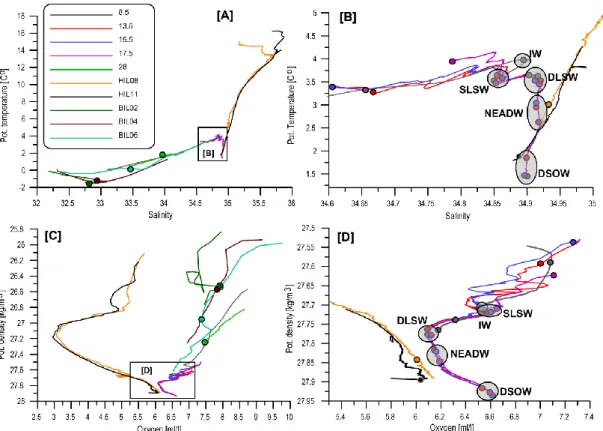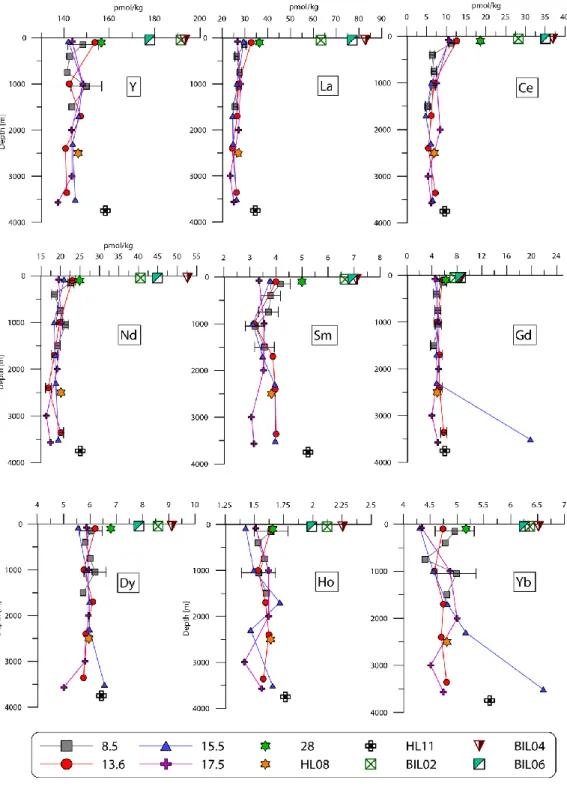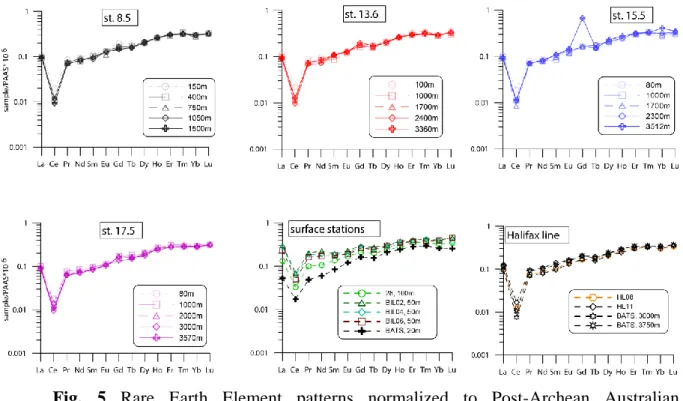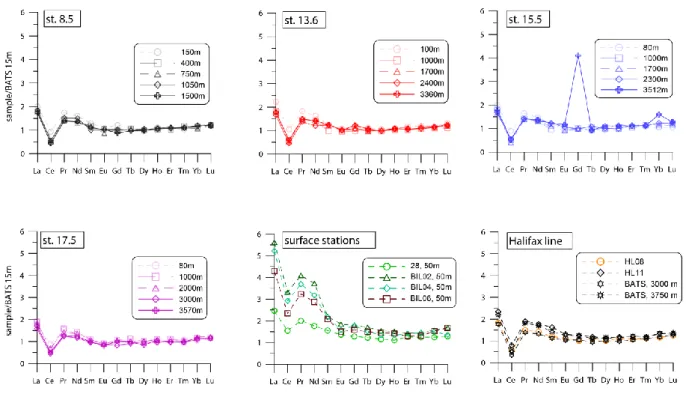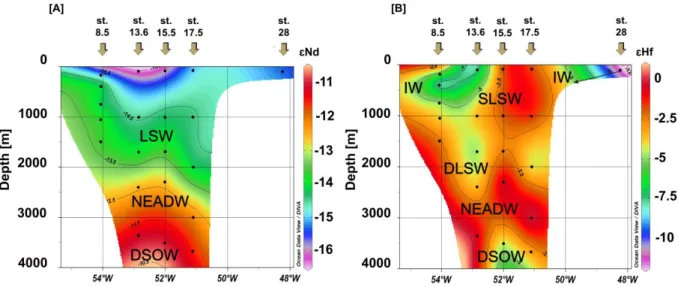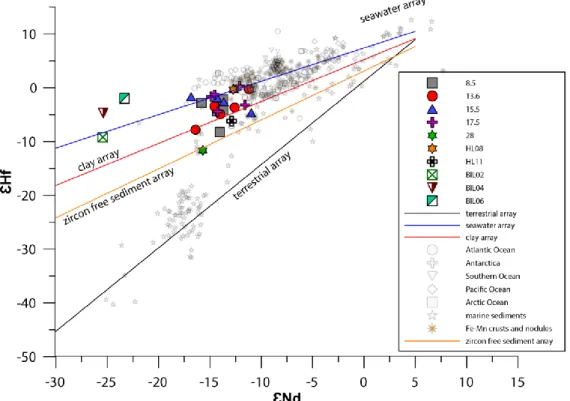1
Reconstruction of the water mass circulation patterns in the Labrador Sea based on
radiogenic isotopes and alkenone composition from
the present day up to the Late Quaternary (35 kyrs) .
DISSERTATION
ZUR ERLANGUNG DES DOKTORGRADES DR. RER. NAT.
DER MATHEMATISCH-NATURWISSENSCHAFTLICHEN FAKULTÄT DER CHRISTIAN-ALBRECHTS-UNIVERSITÄT ZU KIEL
VORGELEGT VON ALEXANDRA FILIPPOVA
KIEL, 2016
2
1. Gutacher und Betreuer: Prof. Dr. Martin Frank 2. Gutachter: Prof. Dr. Markus Kienast
Eingereicht am: 8 November 2016 Datum der Disputation:
Zum Druck genehmigt:
3 Erklärung
Hiermit versichere ich an Eides statt, dass ich diese Dissertation selbständig und nur mit Hilfe der angegebenen Quellen und Hilfsmittel erstellt habe. Diese Arbeit ist unter Einhaltung der Regeln guter wissenschaftlicher Praxis der Deutschen Forschungsgemeinschaft entstanden und wurde weder ganz, noch in Teilen an anderer Stelle im Rahmen eines Prüfungsverfahrens eingereicht.
Teile dieser Arbeit sind bereits veröffentlicht oder sind in Vorbereitung eingereicht zu werden.
Kiel, den
4
CONTENTS
Reconstruction of the water mass circulation patterns in the Labrador Sea based on radiogenic
isotopes and alkenone composition from the present day up to the Late Quaternary (35 kyrs) ... 1
Abstract. ... 9
Zusammenfassung. ... 11
1. Introduction ... 13
1.1 The thermohaline circulation and the Labrador Sea ... 13
1.2 Nd-Hf-Pb isotope geochemistry ... 14
1.2.1 Sm-Nd, Lu-Hf and U-Th-Pb isotope systems ... 15
1.2.2 Continental weathering effects and the sources of the elements in the ocean ... 16
1.2.3 Nd-Hf-Pb signature in the global Ocean. ... 20
1.2.4 Changes of Nd-Hf-Pb isotope signatures through the Late Quaternary ... 23
1.3 Rare earth elements ... 25
1.4 Alkenone paleothermometry ... 28
1.4.1 Genetic variations ... 29
1.4.2 Alkenone alteration in the water column and sediments. ... 29
1.5 Motivation and research questions ... 30
Outline of the thesis and declaration of my contribution to the following chapters ... 32
1.6 Reference list ... 33
Chapter 2 ... 44
Methods ... 44
2. Methods ... 45
2.1 Isotopic composition and REE concentration analysis of seawater samples ... 45
2.1.1 Sampling and preconcentration procedure ... 45
2.1.2 Preparation for separation and column chromatography ... 45
2.1.3 Isotope dilution measurements ... 48
2.2 Sediment samples preparation and column chromatography ... 48
2.2.1 Leaching of marine sediment samples ... 48
5
2.2.2 Total dissolution procedure of the detrital fraction ... 49
2.2.3 Column chromatography ... 50
2.3 Foraminifera analysis ... 52
2.4 Mass spectrometry measurement ... 53
2.4.1 Isotopic composition measurements ... 53
2.4.2 Isotope dilution measurements ... 55
2.4.3 REE concentration measurements ... 55
2.5 Alkenone unsaturation ratio analysis ... 56
2.5.1 Alkenone extraction and separation. ... 56
2.5.2 GC measurements. ... 57
Reference list ... 58
Chapter 3. ... 59
Water mass circulation and weathering inputs in the Labrador Sea based on coupled Hf-Nd isotope compositions and rare earth element distributions. ... 59
Abstract. ... 60
3.2 Introduction ... 61
3.3 Materials and Methods ... 63
3.3.1 Seawater ... 63
3.3.2 Hydrography ... 66
3.3.3 Methods ... 68
3.4 Results ... 72
3.4.1 REE and Hf concentrations in seawater ... 72
3.4.2 Nd isotope compositions ... 74
3.4.3 Hf isotope compositions ... 76
3.5 Discussion ... 77
3.5.1 REE distribution and patterns and Hf concentration ... 77
3.5.2 Isotopic signature of different water masses ... 79
3.6 Conclusions ... 87
Acknowledgments... 87
6
References ... 88
Chapter 4. ... 96
Alkenone paleothermometry in the North Atlantic: A review and synthesis of surface sediment data and calibrations ... 96
4.1 Abstract. ... 97
4.2 Introduction ... 97
4.2.1 Calibration at the low temperature end in the North Atlantic region ... 99
4.3 Methods ... 102
4.3.1 Analytical methods ... 102
4.3.2 Data sources and analysis ... 103
4.3.3 Age constraints ... 104
4.4 Results ... 104
4.5 Discussion ... 6
4.5.1 Introduction of allochthonous alkenones and lateral advection ... 6
4.5.2 Temperature stratification in the Nordic Seas ... 8
4.5.3 Non-modern core top samples ... 9
4.5.4 Comparison of uncertainty of temperature proxies at the cold end ... 9
4.6 Summary and conclusions ... 10
Acknowledgements ... 11
Reference list ... 12
Chapter 5 ... 16
Labrador Sea surface water circulation over the last 35 kyrs inferred from alkenone paleothermometry. ... 16
Abstract. ... 17
5.2 Introduction. ... 17
5.2.1 Study area ... 19
5.3 Sample material and methods. ... 21
5.3.1 Sample material. ... 21
5.3.2 Methods. ... 22
7
5.4 Results. ... 23
5.4.1 Alkenone concentration. ... 23
5.4.2 Alkenone unsaturation ratio ... 24
5.4.3 Sea surface temperatures. ... 25
5.5 Discussion. ... 28
5.5.1 Period from 33 ka to 11 ka. ... 28
5.5.2 Holocene. ... 30
5.6 Conclusions. ... 32
Acknowledgment. ... 33
Reference list. ... 33
Chapter 6 ... 37
Changes in water mass circulation and weathering inputs in the Labrador Sea over the last 35 kyrs based on Nd-Hf-Pb isotope compositions of marine sediments. ... 37
Abstract. ... 38
6.2 Introduction. ... 38
6.3 Materials and Methods. ... 41
6.3.1 Materials ... 41
6.3.2 Methods ... 43
6.4 Results. ... 45
6.4.1 Reliability of the seawater data. ... 45
6.4.2 Nd isotope composition ... 47
6.4.3 Hafnium isotope composition. ... 50
6.4.4 Lead isotope composition ... 52
6.5 Discussion. ... 54
6.5.1 Changes of the seawater radiogenic isotope compositions over time. ... 54
6.5.2 Isotope signature of the totally dissolved detrital fraction. ... 61
6.6 Conclusions. ... 65
Acknowledgements. ... 66
Reference list. ... 66
8
Summary. ... 73
Outlook ... 75
Appendix ... 77
Chapter 4 ... 77
Chapter 5 ... 86
Chapter 6 ... 93
Acknowledgements. ... 108
Curriculum Vitae ... 109
9
ABSTRACT.
The Labrador Sea plays a crucial role in influencing the strength of the Atlantic Meridional Overturning Circulation (AMOC), as it is one of the main deep water formation sites. Numerous studies have been carried out in the Labrador Sea, covering different aspects and time scales. This thesis presents an investigation of the complex processes that prevail in the Labrador Sea covering surface, intermediate and deep waters using a combination of organic (alkenone paleothermometry) and inorganic (radiogenic isotopes) geochemical proxies.
Over the past decades it has been debated, whether or not the alkenone unsaturation ratio can reliably be used as a paleo sea surface temperature proxy, especially in cold environments. Many studies have been published presenting contradicting results. In Chapter 4 an investigation of the proxy reliability was carried out based on available and newly obtained data from the western North Atlantic region. The results show that if certain conditions are met, such as appropriate age control of sediment samples, sufficient distance from the main ocean frontal systems characterized by high SST gradients, low risk of allochthonous input, alkenone-derived temperatures can be reliably used even in the cold regions of the North Atlantic.
These results were applied to reconstruct sea surface temperatures in the Labrador Sea over the last 35 kyrs based on alkenone unsaturation ratio of marine sediment samples from four cores (Chapter 5). The motivation of this study was to reconstruct the variability of sea surface conditions in the area and correlate it to presence or absence of cold/warm surface water currents. The sediment cores used in this study were recovered from around the Labrador Sea following the flow path of the main alongshore currents. Prior to 10 ka the record was only partially preserved and indicated significantly cold temperatures and negative 𝑈37𝐾 values, suggesting that these data are unreliable. However, alkenone unsaturation ratios provided reliable sea surface temperature estimations over the Holocene. The study showed that the Holocene was a period of unstable climate in the Labrador Sea area, characterized by multiple temperature fluctuations that were caused by increased cold water input from the Arctic or fresh water inputs from land.
The investigation of the intermediate and deep waters in the Labrador Sea in this thesis was based on the Hf-Nd-Pb radiogenic isotope signatures of various archives such as sediment samples, foraminifera, detrital material and seawater. The named above isotopes have been used as a proxies for water mass mixing and weathering inputs over the past two decades and were shown to be a reliable tool in paleoceanography.
10
The Labrador Sea is a complex and dynamic region where the depth of the water formation varies from year to year. To be able to resolve these changes in the past more information is needed concerning mechanisms and processes crucial for the formation of the present day Hf-Nd isotope signatures of different water masses. In Chapter 3 new data were obtained from the Labrador Sea based on direct measurements of seawater. The results showed that all water masses present in the Labrador Sea have distinct hafnium and neodymium isotope signatures. However, some of the water masses such as the Irminger water and shallow and deep Labrador Sea Water are more distinctive in their hafnium isotope signatures compared to those of neodymium. This study suggests that ɛHf signatures of the main water masses in the Labrador Sea were most likely mainly formed due to weathering inputs from the surrounding terrains. Higher variability of ɛHf signatures suggests that its residence time is significantly shorter that previously assumed. The new data allow us to conclude that although tracing of large scale ocean mixing processes may not be possible based on Hf isotopes, there is clearly prospect for their application in other restricted basins with similar geological and hydrographic settings.
Based on the above understanding in Chapter 6 combined Hf, Nd and Pb isotopes were applied for the reconstruction of the intermediate and deep water mass circulation in the Labrador Sea over the last 35 kyrs. The results show that all three isotope proxies could be reliably extracted from marine sediments. The new data suggest an early inception of the Denmark Strait Overflow Water around 12 ka, based on ɛNd and ɛHf signatures of the leachates and detrital fraction. The ɛHf and ɛNd signatures of the detrital fraction suggest the establishment of the alongshore Labrador current around 12 ka. The modern day circulation patterns were most likely absent prior 8 ka. Combined Hf-Nd-Pb isotope signatures suggest that convection during the late Holocene in the Labrador Sea may have been more intensive and formation of the Labrador Sea Water reached significantly deeper than today to up to 2600 m. The position of the new data on ɛHf-ɛNd plots forms its own new trend termed “the Labrador Sea” array, which could be representative of the weathering of particular rocks in the source areas of the waters around the Labrador Sea.
11
ZUSAMMENFASSUNG.
Die Labradorsee spielt eine entscheidende Rolle in der Atlantischen Meridionalen Umwälzzirkulation, da sie eines der Hauptgebiete für Tiefenwasserbildung ist. Zahlreiche Studien wurden in der Labradorsee durchgeführt, wobei verschiedene Aspekte und unterschiedliche Zeitskalen abgedeckt wurden. Jedoch setzte keine dieser Studien den Fokus auf mehr als nur einen Aspekt. Die vorliegende Arbeit umfasst eine umfangreiche Untersuchung der Oberflächen-, Zwischen- und Tiefenwässer der Labradorsee basierend auf einer Kombination aus organischen (Alkenon-Paläothermometrie) und anorganischen (radiogene Isotope) geochemischen Proxies.
In den vergangenen Jahrzehnten wurde diskutiert, ob das ungesättigte Alkenon-Verhältnis - insbesondere in kalten Umgebungen - zuverlässig als Proxy zur Bestimmung der Paläo- Oberflächenwassertemperaturen (sea surface temperature, SST) herangezogen werden kann. Viele veröffentlichte Studien präsentierten widersprüchliche Ergebnisse. In Kapitel 4 der vorliegenden Arbeit wurde eine unabhängige Untersuchung der Proxy-Zuverlässigkeit basierend auf bereits publizierten und neuen eigenen Daten aus der westlichen Region des Nordatlantiks durchgeführt.
Diese Studie zeigt, dass die aus den Alkenonen abgeleiteten Temperaturen selbst in kalten Regionen zuverlässig verwendet werden könnten wenn eine Reihe von Bedingungen erfüllt wird, darunter eine angemessene Alterskontrolle der Proben, eine Position abseits der primären Ozean-Frontalsysteme mit hohen SST-Gradienten, sowie geringe allochthone Einträge.
Diese Erkenntnisse wurden verwendet, um die Variabilität der Oberflächenwasserströme in der Labradorsee in den letzten 35 tausend Jahren zu untersuchen, wo SST anhand des ungesättigten Alkenon-Verhältnisses von marinen Sedimentproben aus vier Sedimentkernen rekonstruiert wurden (Kapitel 5). Ziel dieser Studie war es, die Variabilität der Meeresoberflächenbedingungen in der Region zu rekonstruieren und diese mit der An-/Abwesenheit von Kalt- oder Warmwasser- Oberflächenwasserströmen zu korrelieren. Sedimentkerne wurden dabei aus der gesamten Labradorsee entlang des Strömungspfades der küstenparallelen Ströme entnommen. Obwohl die Sedimentabfolge den Zeitraum vor zehn tausend Jahren nur zum Teil abdeckt, bietet das ungesättigte Alkenon- Verhältnis zuverlässige Schätzungen der SST für das Holozän. Die Studie charakterisiert das Holozän als eine Periode des instabilen Klimas, gekennzeichnet durch mehrere Temperaturschwankungen, die entweder durch die Erhöhung der Kaltwasserzufuhr aus der Arktis oder durch Frischwasserzufuhr vom Land verursacht wurden.
Die Untersuchung der Zwischen- und Tiefenwässer der Labradorsee basierte auf den radiogenen Hafnium- (Hf-), Neodym- (Nd-) und Blei- (Pb-) Isotopensignaturen aus verschiedenen Archiven, darunter Sedimentproben, Foraminiferen, detritischem Material und Meerwasser. Diese Isotopensysteme wurden seit Jahrzehnten als Proxy für Wassermassenmischungen und Verwitterungseinträge herangezogen, und wurden als zuverlässige Werkzeuge für paläozeanographische Untersuchungen befunden.
12
Die Labradorsee ist eine komplexe dynamische Region, in der die Tiefenwasserbildung von Jahr zu Jahr variiert. Um diese Änderungen in der Vergangenheit nachvollziehen zu können, ist das Verständnis der Mechanismen und Prozesse, die eine wichtige Rolle bei der Bildung der Hf- und Nd- Isotopensignaturen unterschiedlicher Wassermassen in der heutigen Zeit spielen, erforderlich. In Kapitel 3 wurden neue Daten aus der Labradorsee, basierend auf direkten Messungen von Meerwasser, herangezogen. Die Ergebnisse zeigten, dass Hf-Isotopensignaturen (repräsentiert durch ɛHf) eine bessere Auflösung einiger der Wassermassen, wie etwa Irminger Wasser und flaches und tiefes Labrador-Meerwasser erlauben, welche basierend auf Nd-Isotopensignaturen (repräsentiert durch ɛNd) nicht unterscheidbar sind obwohl alle Wassermassen in der Labradorsee deutliche Hf- und Nd-Isotopensignaturen aufweisen. Die Studie deutete darauf hin, dass die Hf-Isotopensignaturen der wichtigsten Wassermassen in der Labradorsee am wahrscheinlichsten durch Verwitterungseinträge aus den umliegenden Terrains gebildet wurden. Die höhere Variabilität der ɛHf-Signaturen legt nahe, dass die Verweilzeit von Hf um eine Größenordnung kleiner ist als bisher angenommen. Obwohl die Verfolgung von großflächigen Ozeanmischungsprozessen basierend auf Hf Isotopen nicht möglich erscheint, deuten die Daten auf ein klares Potential für die Anwendung von Hf Isotopen in anderen Randbecken mit ähnlichen geologischen und hydrographischen Konditionen.
Die kombinierten Hf-, Nd- und Pb- Isotopensysteme wurden mit Hilfe der oben genannten Erkenntnisse angewandt um die Zirkulation von Zwischen- und Tiefenwässern der Labradorsee für die letzten 35 tausend Jahre zu rekonstruieren (Kapitel 6). Die Ergebnisse zeigen, dass alle drei Isotopen- Proxies zuverlässig aus marinen Sedimenten extrahiert werden konnten und dass ihre Änderungen eng miteinander korrelieren. Basierend auf den angelösten und detritischen ɛHf- und ɛNd-Signaturen zeigen die neuen Daten, dass Überlaufwasser aus der Dänemarkstraße vor rund 12 tausend Jahren eintrat. Die ɛHf- und ɛNd-Signaturen der detritischen Fraktion zeigen die Etablierung des küstenparallelen Labradorstroms bei etwa 12 tausend Jahren vor heute. Die modernen Zirkulationsmuster waren allerdings höchstwahrscheinlich bis vor acht tausend Jahren noch nicht vorhanden. Die kombinierten Hf-Nd-Pb-Isotopensignaturen legen nahe, dass Konvektion in der Labradorsee während des späten Holozäns viel intensiver gewesen sein könnte, und dass die Bildung des Labrador Meerwassers viel tiefer war als heute. Die Lage der neuen Daten auf der ɛHf-ɛNd Abbildung bildet einen eigenen neuen Trend der hier als "Labradorsee-Array“ bezeichnet wird, welcher den Eintrag eines bestimmten Gesteinstyps aus den Quellbereichen rund um die Labradorsee repräsentieren könnte.
13
1. INTRODUCTION
1.1 THE THERMOHALINE CIRCULATION AND THE LABRADOR SEA The ocean plays an important role in controlling regional and global climate. Short (decadal) and long term changes and fluctuations of the climate system in the past, in many instances, were predetermined by changes of the ocean circulation, which is driven by meridional heat and fresh water transport (cf. Dickson et al., 1988; Dommenget and Latif, 2002; Gulev et al., 2001). Understanding the mechanisms controlling the global ocean variability, and regular observations of the integral parts of the ocean systems, is therefore of great necessity not only for climatic modelling of the past but also for forecasting global climate dynamics in the future.
Heat exchange between the atmosphere and the ocean and heat transport from equatorial regions to high latitudes drives the so called Atlantic Meridional Overturning Circulation (AMOC). Understanding the dynamics and variability of the AMOC is crucial for climate change predictions. Variations in the processes of deep water convection and water mass formation in the past and in the modern time have been a focus of many studies (e.g.
Dickson and Brown, 1994; Vellinga and Wood, 2002; Hall et al., 2006; Chen et al., 2012;
Trouet et al., 2012; McCarthy et al., 2014).
One of the main deep water formation sites that plays a crucial role in influencing the AMOC strength and variability is the Labrador Sea. As the receiving basin of warm and saline waters from South Atlantic, which are brought there by the western branch of the North Atlantic current, and as one of the biggest sources of fresh and cold waters together with the polar regions, it significantly contributes to the formation of the deep and surface outflows to the Atlantic ocean (Yashayaev et al., 2015). The annual accumulation of cold and fresh water and its injection into the deeper layers makes the Labrador Sea the freshest and coldest basin of the Subpolar North Atlantic (SPNA) (Yashayaev et al., 2015). Wind driven convection, promoted by strong winter cooling, leads to the formation of Labrador Sea Water (LSW), which is being transported out of the Labrador Sea and is entrained in North Atlantic Deep Water (NADW) (Yashayaev and Clark, 2006; Yashayaev and Loder, 2009). Via surface and deep water mixing processes, dissolved atmospheric gases such as carbon dioxide, oxygen, nutrients and chlorofluorocarbons (CFCs) are added to LSW and are transported outside the Labrador Sea to intermediate depths of the North Atlantic ocean, thereby both ventilating the deeper parts of the Atlantic Ocean and removing atmospheric CO2 (Lazier et al., 2002;
Azetsu-Scott et al., 2003). The deep convection that takes place in the Labrador Sea is also crucial for AMOC dynamics given that it produces the densest water mass within the SPNA
14
(Yashayaev et al., 2015). Wind driven cooling that occurs in winter at the surface of the Labrador Sea is considered to be one of the main factors that control the size and strength of the subpolar gyre in the North Atlantic (Yashayaev et al., 2015).
Of particular importance for the water convection in the Labrador Sea are the upper 200 meters, which exert the largest and strongest control over the vertical stratification and mixing of the depth range of the upper 1000 m (Yashayaev et al., 2015). Accumulating fresh water from various internal sources throughout the year, such as continental runoff, precipitation, Arctic outflow waters, or ice melt, this layer captures important signals, which are subsequently spread in the surface and subsurface waters of SPNA and also injected into the deeper layers (Yashayaev et al., 2015). Increased fresh water inputs into the Labrador Sea lead to changes in surface and subsurface salinity thus intensifying vertical stratification and slowing down winter convection in the region, and at the same time increasing salinity and temperature of the deeper layers (Yashayaev et al., 2015).
The ability to trace and understand these processes is crucial for the reliability of our future climate predictions. Regular annual monitoring cruises in the Labrador Sea provided good quality climate records over the last few decades (Yashayaev and Clark, 2006;
Yashayaev et al., 2008; Yashayaev et al., 2015). However to be able fully understand the ongoing processes and their role and significance in global climate change, records of the past ocean circulation are necessary. By means of applying innovative and established methods in paleoceanography we can obtain crucial information on the surface and deep water mass circulation patterns in the Labrador Sea that prevailed in the region in the past and compare it to the modern trends. The tools applied in this study are discussed in the following chapter.
1.2 ND-HF-PB ISOTOPE GEOCHEMISTRY
Long-lived radioactive systems are widely applied tools in paleoceanography to trace Earth system processes through geological time (Goldstein and Hemming, 2003). Some of the main parent-daughter systems used are Th-U-Pb, Sm-Nd and Lu-Hf. Long-lived systems are considered those that have a slow rate of decay comparable to the age of the solar system.
Due to their very slow rate of decay, changes in the abundances of the stable daughter isotopes, referred to as “radiogenic” can be considered negligible on short millennial time scales and are denoted as a ratio to a primordial stable isotope of the same element that has not experienced ingrowth due to radioactive decay. The radiogenic isotope ratios of rocks are thus a function of the parent-daughter element ratios and the ages. Ideally, the element systems applied for the evaluation of present and past water mass mixing behave
15
conservatively in sea water and will only reflect mixing the source signatures of the water masses. Due to transport processes on the Earth surface, radiogenic isotope signatures in the weathering solutions represent mixtures of contributions from the different age terrains.
Dissolved elements and their isotope ratio can be traced over their entire path in the ocean, as long as no additional inputs with different isotope ratios were added on the way (Goldstein and Hemming, 2003). There are three main ways of how dissolved elements can be introduced into the ocean, via rivers, from aeolian, or hydrothermal inputs (Frank, 2002). The importance of these sources for different isotope systems varies depending on the element mobility during weathering and erosional processes and chemical behavior. Below, the Sm- Nd, Lu-Hf and Th-U-Pb isotope systems are discussed in more detail.
1.2.1 SM-ND, LU-HF AND U-TH-PB ISOTOPE SYSTEMS
Sm is a rare earth element with seven naturally occurring isotopes, three of which are radioactive (147Sm, 148Sm, 149Sm). The latter two have extremely long half-lives (> 1016) and therefore do not produce measurable amounts of the daughter isotopes 144Nd and 145Nd (Dickin, 2005). However, the half-life of 147Sm (14.99 % abundance) is short enough (106 Gyr) to produce small but measurable changes in the abundance of 143Nd over time.
Nd is also a rare earth element that has seven naturally occurring stable isotopes (142Nd, 143Nd, 144Nd, 145Nd, 146Nd, 148Nd and 150Nd). 143Nd (abundance 12.18 %) is produced due to α-decay of 147Sm. The Sm/Nd ratio of the mantle is higher than that of the crust, and it follows that the 143Nd/144Nd ratio is higher in the mantle than in the crust. Sm/Nd and
143Nd/144Nd ratios of the bulk Earth are considered to be the same as of chondritic meteorites, which are believed to closely represent the composition of the bulk Earth prior to differentiation of mantle and crust (Frank, 2002; Goldstein and Hemming, 2003; Dicken, 2005). Due to the small differences in 143Nd/144Nd ratios (four or fifth place after the decimal), Nd isotope ratios are expressed as ɛNd values:
ɛNd=(
143𝑁𝑑
144𝑁𝑑𝑠𝑎𝑚𝑝𝑙𝑒)−(143𝑁𝑑 144𝑁𝑑𝐶𝐻𝑈𝑅) 143𝑁𝑑
144𝑁𝑑𝐶𝐻𝑈𝑅 ∗ 10000,
where CHUR represents the present-day chondritic 143Nd/144Nd value of 0.512638 (Jacobssen and Wasserburg, 1980).
Lutetium is the heaviest of the rare earth elements (REEs) of the lanthanide series. It has two isotopes 175Lu and 176Lu with the first being most abundant (97.4 %) and the second 2.6% respectively. 176Lu decays into 176Hf by β- emission (Dicken, 2005) and is left in an excited state and then decays to the ground state by γ emission. This isotope is one of the six
16
stable Hf isotopes (174Hf, 176Hf, 177Hf, 178Hf, 179Hf and 180Hf), and constitutes 5.2 % of total hafnium (Dicken, 2005). Hafnium as an element is not a REE but closely resembles Zr in its chemical behavior (Dicken, 2005).
The Hf system is in many aspects similar to Sm-Nd. Both elements are relatively immobile and refractory, and the bulk Earth’s Lu/Hf ratio is assumed to be close to chondritic.
The 176Hf/177Hf ratio is lower in the crust in comparison to the mantle (White, 2000).
176Hf/177Hf ratio is expressed as an ɛHf:
ɛHf=(
176𝐻𝑓
177𝐻𝑓𝑠𝑎𝑚𝑝𝑙𝑒)−(176𝐻𝑓 177𝐻𝑓𝐶𝐻𝑈𝑅) 176𝐻𝑓
177𝐻𝑓𝐶𝐻𝑈𝑅 ∗ 10000,
where CHUR represents chondritic 176Hf/177Hf value of 0.282785 (Nowell et al., 1988;
Bouvier et al., 2008).
Lead has four stable isotopes 204Pb, 206Pb, 207Pb and 208Pb, only one of which, 204Pb, is non radiogenic. 206Pb, 207Pb and 208Pb are the final decay products of the uranium (238U, 235U) and thorium (232Th) decay series respectively, in which the intermediate members of the decay chain are relatively short-lived. The half-life of 238U is comparable to the age of the Earth whereas the half-life of 235U is much shorter, resulting in almost all primordial 235U having decayed to 207Pb. The half-life of 232Th is comparable to the age of the universe. The bulk Earth composition of U-Th-Pb system is less well defined than that of Sm-Nd and Lu- Hf. It is complicated by the volatility of Pb during nebular condensation and the high variability in depletion of volatile elements in the Earth (Goldstein and Hemming, 2003).
Fractionation of the U-Th-Pb system between the crust and the mantle is less well defined and isotopic differences between them appear to be relatively small (Asmerom and Jacobsen, 1992).
1.2.2 CONTINENTAL WEATHERING EFFECTS AND THE SOURCES OF THE ELEMENTS IN THE OCEAN
The applicability of long-lived radiogenic isotope systems is based on their variability within the Earth and at its surface. This variability is a result of the gross chemical differentiation of the Earth associated with magmatic processes, as different isotope systems behave differently during magma formation. The behavior of the Sm-Nd system is similar to that of Lu-Hf in that Nd and Hf are less compatible than their parent isotopes during magma generation. As a result, Nd and Hf are more likely to enter the melts than Sm and Lu leading to a lower Sm/Nd and Lu/Hf ratios in the continental crust compared to the mantle. As time passes, this results in low 143Nd/144Nd and 176Hf/177Hf in the continental crust compared to the
17
mantle and bulk Earth (negative ɛNd and ɛHf). Consequently, young mantle derived rocks, such as mid-ocean ridge and ocean island basalts, have high 143Nd/144Nd and 176Hf/177Hf (positive ɛNd and ɛHf). With age, the distinction between continental and mantle isotope ratios increases. As the age of the continental crust is geographically variable, continents are isotopically heterogeneous, forming the basis for tracing the sources and transport. The similar fractionation behavior of Hf and Nd during the formation of the continental crust results in a strong positive correlation of radiogenic Nd and Hf isotopes in most terrestrial rocks, which has been defined as a “mantle-crust array” or “terrestrial array” (Fig. 1, ɛHf= 1.55 * ɛNd+ 1.21, Vervoort et al., 2011).
However, unlike Sm and Nd, Lu and Hf undergo significant fractionation due to weathering and sediment transport (Dickin, 2005). In comparison to 147Sm/144Nd, 176Lu/177Hf is strongly fractionated between sandstones and clays. Patchett et al. (1984) explained this effect by the affinity of Hf to be incorporated in zircons (~ 1% by weight), whereas at the same time zircons do not incorporate large amounts of Lu. Consequently, with time this results in less radiogenic signatures of zircons than the corresponding bulk rocks. Zircons are highly resistant to chemical and physical weathering and have low Lu/Hf and 176Hf/177Hf ratios. They are enriched in sand-grade sediments and Hf is depleted in the fine-clay fraction.
Sorting of marine sediments during transport according to grain size leads to low Lu/Hf ratios of sand and turbidites on continental shelves and continental slopes, medium Lu/Hf ratios in shales and clays and very high ratios in red clays and Mn nodules in the deep ocean due to the absence of terrigenous sediments (van de Flierdt et al., 2002; Dickin, 2005; Carpentier et al., 2008). Hf released to the weathering solutions is consequently expected to be more radiogenic than the bulk rocks (van de Flierdt et al., 2002, 2007). The observed effect of Hf fractionation during weathering caused by zircons was termed as a “zircon effect” (van de Flierdt et al., 2007).
18
Fig. 1 Hf-Nd isotope systematics of marine sediments, ferromanganese crusts and nodules, detrital fraction, atmospheric dust and seawater. Terrestrial array (ɛHf= 1.55 * ɛNd+ 1.21, Vervoort et al., 2011) and seawater array (ɛHf= 0.62 * ɛNd+ 7.38, Albarède et al., 1998; Godfrey et al., 1997; David et al., 2001) are shown on the plot. Data are taken from:
marine sediments (Bayon et al., 2008; Vervoort et al., 2011; Chen et al., 2012; Garcon et al., 2013), ferromanganese crusts and nodules (Albarede et al., 1998; David et al., 2002), detrital fraction (Chen et al., 2012; Chen et al., 2013), seawater (Godfrey et al., 2009; Rickli et al., 2009, 2010, 2014; Stichel et al., 2012a,b; Zimmermann et al., 2009a,b; Filippova et al., 2016 submitted to GCA), dust samples (Chen et al., 2013).
Early studies of dissolved Hf-Nd isotope composition of seawater based on the ferromanganese nodules and crusts, which directly precipitate from seawater, showed the consequence of these fractionation processes and the fact that seawater forms a distinct and well defined correlation between Hf and Nd as well. For every given value of ɛNd, a more radiogenic value of ɛHf than expected from the bulk rock composition is observed (Fig. 1).
This trend, which deviates from the “terrestrial array”, is referred to as the “seawater array”
(ɛHf= 0.62 * ɛNd+ 7.38, Albarède et al., 1998; Godfrey et al., 1997; David et al., 2001). The direct measurements of seawater carried out over the last decade confirmed the existence of the seawater array. Initially, the formation of the seawater array was mainly ascribed to the
19
zircon effect (Bayon et al., 2006; Rickli et al., 2013). However, there was also the claim that an additional source of highly radiogenic Hf contributed to the offset formation, and suggested hydrothermal input as a potential contributor of highly radiogenic Hf (Bau et al., 2006). The similar behavior of Nd and Hf and the absence of hydrothermal contributions of Nd to seawater (Michard et al., 1983; German et al., 1990; Halliday et al., 1992) were used as an argument against significant inputs of highly radiogenic hafnium to the oceans. This, however, still remains to be proven by direct measurements of Hf in hydrothermal solutions (van de Flierdt et al., 2004a,b; Bau and Koschinsky, 2006; Firdaus et al., 2011). More recent studies, based on isotopic mass balance calculations, showed that the seawater offset cannot be explained by the zircon effect only (Chen et al., 2011). Instead, it has been proposed that preferential weathering of labile minerals with high Lu/Hf, such as apatite and sphene play an important role (Barford et al., 2003; Bayon et al., 2009; Godfrey et al., 2009; Chen et al., 2011). The role of aeolian input to the oceans as the source of radiogenic Hf has also been evaluated. Pettke et al., 2002a came to a conclusion, that dust bound Hf may have been a significant source of seawater Hf and seawater Nd. However it seems that this scenario is appropriate only at times when dust fluxes have been extremely high, such as in the North Pacific over the past few millions years (Pettke et al., 2002a). On the other hand, prior to the Pliocene dust bound Hf most likely had little or no effect (Pettke et al., 2002a,b). A recent study by Rickli et al. (2011), carried out on dust samples from the Saharan desert, showed that dust dissolution in seawater is a significant source for the marine REE budget. Hafnium, however, unlike Nd, is being released from the dust incongruently, most likely from more labile or secondary minerals, such as clays and possibly apatite. Consequently, the dissolved Hf isotopes do not reflect the bulk signal of the dust, and depending on the dust load isotopic composition of Saharan dust may be similar to seawater, making it hard to truly asses the significance of dust dissolution as a source of radiogenic Hf in seawater (Rickli et al., 2011).
Unlike Hf, Nd isotopes are generally not significantly influenced by fractionation during weathering processes (Goldstein et al., 1984). However, it has been proposed that minor fractionation effects may occur due to preferential release of unradiogenic Nd from minerals with low 143Nd/144Nd isotope ratios. This has been observed during weathering of glacial tills (Öhlander et al, 2000) and during erosion and partial dissolution of rocks that supply boreal rivers in northern Scandinavia (Andersson et al., 2001). Blanckenburg and Nägler (2001) came to the same conclusions based on their leaching experiments of Greenland river sediments. Hydrothermal input does not contribute to the dissolved seawater Nd budget due to high particle reactivity and immediate scavenging of Nd within
20
hydrothermal vents (German et al., 19990; Halliday et al., 1992). Numerous studies of the Nd budget showed that dust is an important source of dissolved Nd (Goldstein et a., 1984;
Greaves et al., 1999; Rickli et al., 2011). One of the main sources of dissolved Nd to the global ocean is riverine input, a large fraction of which is being trapped in estuaries.
However, up to 90% of Nd delivered to the ocean is being transported on colloids (Andersson et al., 2001). Lacan and Jeandel (2005) showed that there is an additional flux of Nd from the continental slope sediments, due to their leaching and mobilization, which leads to exchange and release of Nd to seawater. This process was termed “boundary exchange” and was also observed by other authors in later studies (Rickli et al., 2009; Wilson et al., 2012).
Lead isotope ratios do not display a strong correlation with Hf-Nd in continental rocks and oceanic basalts (Goldstein and Hemming, 2003), which usually express similar values for example in their 206Pb/204Pb ratios. In a graph of 206Pb/204Pb versus 207Pb/204Pb, oceanic basalts normally fall below the continental rocks, which is a consequence of the short half-life of 235U in comparison to 238U and higher U/Pb ratio in the continental crust than in the mantle over the first half of Earth’s history (Goldstein and Hemming, 2003), and continental crust derived lead can in most cases be distinguished from mantle derived lead. During weathering of continental rocks lead is fractionated, which is mainly caused by the radiation damage to the crystal lattice of the minerals during the radioactive decay of the parent isotopes. As a result the daughter isotopes are left loosely bound in the minerals, which causes their preferential mobilization at the grain boundaries (cf. Frank, 2002). As a consequence, radiogenic lead isotopes (206Pb, 207Pb, 208Pb) are easier mobilized from rocks and minerals during weathering than nonradiogenic 204Pb. Thus, Pb isotope compositions of weathered solutions and dissolved Pb in seawater do not directly reflect the Pb isotope signature of the bulk source rocks (Blanckenburg and Nägler, 2001). The importance of the natural sources of lead in seawater is different from Nd and Hf. Besides riverine supply being the most important source of dissolved lead, hydrothermal inputs are at least of local importance (Barett et al., 1987). However on the global scale these inputs are considered to be relatively small (< 2%) (Chen et al., 1986). Dust inputs account for only 10-12 % of the preanthropogenic lead budget.
1.2.3 ND-HF-PB SIGNATURE IN THE GLOBAL OCEAN.
The first studies based on the long-lived radiogenic isotope systems were carried out on ferromanganese nodules and crusts and marine sediments, but with the advance of analytical techniques direct measurements of seawater became possible.
21
The first studies of the neodymium isotopic composition of the ocean were published in the late 70s (Richard et al., 1976; DePaolo and Wasserburg, 1976a; O’Nions et al., 1977).
One of the first reports of Nd, along with Pb and Sr isotopes in manganese nodules and hydrothermal sediments was provided by O’Nions et al. (1978). These authors confirmed that the main source of neodymium is continents. However, they also inferred - incorrectly - that Nd is globally well mixed in the oceans and that its isotopic signature only covers a very narrow range. In the following years, studies carried out by Piepgras et al. (1978) and Goldstein and O’Nions (1981) showed distinct Nd isotopic signatures for the Pacific, Atlantic and Indian oceans. The Pacific is dominated by more radiogenic ɛNd values between 0 to -5, the Atlantic is unradiogenic (ɛNd between -10 to -14), and intermediate values between -7 to - 10 characterize the Indian Ocean. Additionally, these authors found some systematic geographic variability within each ocean basin, which they attributed to the difference in age of the surrounding continental crust and potential addition of volcanically derived Nd in the case of Pacific Ocean.
The first direct measurements of seawater were carried by Piepgras et al., (1979) for 4 water samples from the Pacific Ocean and by Piepgras and Wasserburg, (1980) for water samples from the Atlantic. They showed a general agreement of Fe-Mn nodule and crust data with seawater for similar depths. Additionally they found a substantial vertical variability in Nd signature and suggested that North Atlantic Deep Water has a distinct Nd isotope signature, making Nd a potential tool in oceanography and paleoceanography. Since the late 70’s, the neodymium isotope compositions of seawater have been widely measured, which results in a large data set of ɛNd signatures of different water masses in the global ocean ranging from -26.6 to +2.7 (Lacan et al., 2012; Grasse et al., 2012; Fröllje et al., 2016). These data confirm previous findings of well resolved ɛNd signatures for different water masses.
The signals reflect weathering inputs from rocks of different ages and types ranging from old continental crust surrounding the Atlantic Ocean of Proterozoic or Archean age (ɛNd ~ -40) to young mantle derived material surrounding the Pacific Ocean characterized by highly radiogenic signatures of up to +20. The least radiogenic signatures were measured in Baffin Bay waters (-26, Stordal and Wasserburg, 1986). The admixture of water masses with distinct isotope signatures results in the modern day NADW signature of -13.5 (Lacan et al., 2012).
The global average residence time of Nd in the ocean is considered to be on the order of 400 - 1000 years (Arsouze et al., 2009; Rempfer et al., 2011). Nd is generally depleted in the surface waters due to its particle reactivity and scavenging processes at the surface. With depth Nd concentration increases due to desorption/dissolution processes.
22
The first study of seawater Hf isotope compositions based on Fe-Mn nodules from Pacific, Atlantic and Indian Oceans was published in 1986 (White et al., 1986). Despite the coherent behavior of Nd and Hf, and high variability of Nd, hafnium was found to have homogeneous ɛHf values of around +2, with little variation outside analytical uncertainty.
White et al. (1986) explained the homogenous signature of Hf in seawater by the equal admixture of two end members, crustal and mantle sources of dissolved Hf respectively. To achieve such a level of homogenization, however, the residence time of Hf would have to be at least on the order of or longer than the mean ocean mixing time of 1500 years. Due to analytical difficulties of measuring isotope ratios of Hf, the next study was published only 11 years later by Godfrey et al. (1997). Early studies on the behavior of Hf and its isotopic distribution in seawater were based on data of slowly accumulating ferromanganese crusts and nodules (Albarède et al., 1998; David et al., 2001; van de Flierdt et al., 2002, 2004a, 2004b; Bau and Koschinsky, 2006). The advance of MC-ICPMS based measurement techniques allowed the direct measurements of the Hf isotope composition in seawater.
However, due to low concentrations of Hf in seawater (0.04 - 1.47 pmol kg-1) (Godfrey et al., 1996; McKelvey and Orians, 1998) in comparison to Nd (15 - 45 pmol kg-1) (Goldstein and Hemming, 2003) these measurements are analytically challenging and data are still scarce.
Isotopic compositions of Hf in seawater are now available for the Atlantic Ocean (Rickli et al., 2009, 2010; Godfrey et al., 2009), the Southern Ocean (Stichel et al., 2012 a,b; Rickli et al., 2014), the Pacific Ocean (Zimmermann et al., 2009b), the Arctic Ocean (Zimmermann et al., 2009 a), and the central Baltic Sea (Chen et al., 2013). Available global open ocean ɛHf signatures range from -5.7 to +10 (Godfrey et al., 2009 and Rickli et al., 2010). The available data on Hf isotope signatures and Hf concentrations in the global ocean gave rise to controversial discussions on its oceanic residence time. A narrow range of Hf isotope signatures through the oceans implies very long residence time, on the order of 2000 years allowing its homogenization in the global ocean. On the other hand, unlike Nd, Hf concentrations do not increase along the deep ocean conveyor implying a much shorter residence time, on the order of just few hundred years (Rickli et al., 2009).
The interest in oceanic Pb isotope distributions started with attempts to date the age of the Earth by Pb/Pb method (Dickin, 2005). Chow and Patterson (1962) investigated the Pb isotope composition of pelagic sediments, which allowed some considerations about the lead distribution in the oceanic system. Concentration profiles of lead in the water column showed increased surface values, mainly attributed to anthropogenic inputs and depletion at depth (Schaule and Patterson, 1981). Due to high particle reactivity of lead (Schaule and Patterson,
23
1981; Cochran et al., 1990) its residence time in the ocean is considered to be much shorter than that of Nd or Hf and has been estimated at 200-400 years in the Pacific and only about 50 years in the Atlantic (Chow and Patterson, 1962; Craig et al., 1973; Henderson and Maier- Reimer, 2002). The main mechanism of lead transfer to marine sediments is considered to be non reversible scavenging accompanied by release at depth due to remineralization and decomposition of particles. First attempts to measure lead directly in seawater led to the conclusion that it is completely overprinted by anthropogenic inputs as a result of nuclear fallouts and use of lead contained in petrol (Chow and Johnstone, 1965; Chow et al., 1970).
Although it restricted the application of lead to trace its natural isotope composition in seawater, it gave raise to numerous studies on the sources of anthropogenic lead in the ocean (Chow et al., 1970; Sturges and Barrie, 1987; Rosman et al., 1993). Information on the preathropogenic levels of dissolved lead in seawater can only be derived from the records preserved in marine authigenic sediments, such as ferromanganese crusts and nodules (Chow and Patterson, 1959, 1962). Chow and Patterson showed that based on the analysis of Mn nodules from the Atlantic ocean the lead signature is consistent with the continents being the main source , whereas in the Pacific Ocean submarine volcanic activity may be a significant source as well. A study by Abouchami and Goldstein (1995) based on circumpolar Mn nodules showed evidence of the importance of mixing between different water masses for the dissolved Pb isotope distribution. A study by Blanckenburg et al. (1996) based on Mn nodules revealed that within the Atlantic, Pacific and Indian Oceans the Pb signature is more homogenous, than in the circumpolar ocean. More recent studies, however, showed isotopic provinciality of Mn nodules in the deep oceans, where the Pb signature is strongly influenced by mixing between different bodies of water (Jones et al., 2000; Vlastelic et al., 2001). The available data on Pb isotope signatures shows 206Pb/204Pb values of around 19.3 for present NADW and around 18.5-18.8 for the deep Pacific water (Frank, 2002) clearly demonstrating the incongruent weathering release of Pb from the Archean and Proterozoic rocks (206Pb/204Pb signatures of ~13-17) around the North Atlantic. The Indian and Southern oceans are generally intermediate between these values. However, important to notice that the age of the ferromanganese crust surfaces normally integrate tens to hundreds of thousands of years, and may not be representative of the preanthropogenic deep-water Pb signature for shorter periods of time.
1.2.4 CHANGES OF ND-HF-PB ISOTOPE SIGNATURES THROUGH THE LATE QUATERNARY
24
Initially, reconstructions of the past ocean Nd-Hf-Pb isotope signatures were mainly based on the analysis of ferromanganese crusts and nodules (e.g. Frank, 2002). These precipitate directly from ambient seawater and record the isotopic signal of deep waters in the past, which has been confirmed by numerous studies for Nd (O’Nions et al., 1978; Piepgras et al., 1979; Albaredè and Goldstein, 1992; von Blanckenburg et al., 1996 a,b; David et al., 2001;), Hf (Lee et al., 1999; Piotrowski et al., 2000; Pettke et al., 2002), and Pb (Burton et al., 1997; Frank and O’Nions, 1998; von Blanckenburg and O’Nions, 1999). Due to extremely slow growth rate, Fe-Mn crusts integrate the signal over long periods of time, from 104 up to 105 years. This precludes their application for studies of shorter term changes, such as on glacial-interglacial or even shorter time scales, which resulted in the quest for new archives capable of the reconstruction of short term variations in Nd-Hf-Pb isotope signatures of the past ocean.
One of the potential tools to reconstruct Nd isotope signatures were considered foraminifera, which are widely distributed and can yield high resolution profiles, due to their high sedimentation rates (Dickin, 2005). Foraminiferal shells are coated by a layer of ferromanganese oxihydroxides after their deposition on the sea floor, in which Nd concentrations are much higher than those in the foraminiferal carbonate themselves.
Attempts to remove these coatings in order to obtain a surface water Nd isotope composition were presented by Vance and Burton (1999), who applied leaching with a strong reducing agent. The validity of the method was confirmed in 2000 by Burton and Vance, based on analyses of foraminiferal shells from a sediment core from the Indian Ocean. However, some important questions concerning the Nd isotope signature extraction from reductively cleaned foraminifera remain not fully answered. It is still debated which water depth the Nd isotope compositions extracted from the cleaned foraminifera reflect, and the consensus tends to be that they mainly reflect deep water signals (Robert et al., 2012, Pena et al., 2013; Kraft et al., 2013). Laboratory tests showed that no significant amounts of Hf are incorporated into foraminiferal shells (T. Chen, personal communication).
Over the last decade, an additional archive allowing the reconstruction of seawater Nd- Pb-Hf isotope fluctuations was explored. Amorphous authigenic Fe-Mn oxihydroxide coatings of bulk sediments or of foraminiferal shells formed at the sediment water interface are potentially preserving high resolution record of past ocean isotope variability of Nd (e.g.
Rutberg et al., 2000; Bayon et al., 2002; Piotrowski et al., 2005; Gutjahr et al., 2008, 2010;
Jang et al., 2013; Hillaire-Marcel et al., 2013) and of Pb (Fagel et al., 2004; Gutjahr et al., 2009; Crocket et al., 2013). However, caution must be taken during the leaching procedure as
25
the reliability of the results may be in question in some geographical areas due to potential contamination by preformed oxides and/or by the detrital fractions, such as volcanic material, which is easily dissolvable (e.g., Elmore et al., 2011; Wilson et al., 2013). Therefore, the leaching procedure needs to be validated for each location (foram analysis, core-top calibration). The modified procedure for Nd and Pb extraction from ferromanganese coatings of marine sediments has also been successfully transferred for Hf isotopes (Chen et al., 2012;
Gutjahr et al., 2014).
1.3 RARE EARTH ELEMENTS
The rare earth elements consist of 17 transition metals starting from scandium (Sc), yttrium (Y) and the lanthanides. However, traditionally Sc is not included in the REEs due to its small ionic radius. The group of rare earth elements is thus represented by lanthanum (La), cerium (Ce), neodymium (Nd), samarium (Sm), europium (Eu), gadolinium (Gd), terbium (Tb), dysprosium (Dy), holmium (Ho), erbium (Er), thulium (Tm), ytterbium (Yb), lutetium (Lu), and yttrium (Y). REEs are divided into groups based on their atomic number. Low atomic number elements are termed light REE (LREEs) from La to Eu, and heavy REE (HREEs) from Gd to Lu. Y is normally included with HREEs due to its ionic radius, which is nearly identical to Ho (Fig. 2). Some authors divide REEs into three groups, including mid- REE for intermediate members of the series (Chakhmouradian and Wall, 2012).
The distinct differences in the abundances of even numbered elements relative to their odd numbered neighbors define a saw tooth distribution pattern of REEs in terrestrial and extraterrestrial material (Chakhmouradian and Wall, 2012). This saw tooth pattern makes distinction between data difficult and thus normalization of the REEs concentrations to a reference material is widely applied. The material used for normalization is chosen based on the practical and scientific task. For the comparison to the upper continental crust and seawater normally well-homogenized shales are used, in particular Post Archean Australian shale (Fig. 3, Taylor and Mclennan, 1999). Normalized concentrations are plotted on the logarithmic scale.
Fractionation of REEs between melts and crystals is defined by “lanthanide contraction” (Goldschmidt, 1925), a significant reduction in ionic radius from La to Lu, due to increasing attraction of the nuclei and 6s electron of the lanthanides. The Earth’s upper mantle exhibits a depletion in normalized LREEs, whereas the continental crust is enriched in these elements. In the environment REEs are mainly present in an oxidation state of +3. The exceptions are, however, Ce and Eu, which can occur in +2 and +4 oxidation states. Y and Ho
26
express different partitioning behavior in aqueous solutions, which has been attributed to differences in metal-ligand bonding (Choppin, 2002) or to stereochemical changes during the transition from a solute to a solid (Tanaka et al., 2008). Fractionation of REEs in natural systems is driven by these difference’s (radii, ligand bonding and oxidation state).
Fig. 2 Ionic radii of the rare earth elements. Yttrium has almost the same ionic radii as Ho, and is normally included in heavy rare earth element group.
Fig. 3 Composition of Rare Earth Elements in different rock standards: average chondrites values, plotted against second Y-axis on the right (Schmidt et al., 1963), Post Archean Australian Shale values (McLennan, 2001), North American Shale values (Gromet et al., 1984), Upper Continental Crust values (Wedepohl, 1969-1978; Rudnick and Gao, 2003;
McLennan, 1989).
27
In seawater, REEs are mainly introduced through atmospheric inputs (Ederfield and Greaves, 1982; De Baar et al., 1983; Scholkovitz et al., 1993; Tachikawa et al., 1999) and via rivers (Goldstein et al., 1984; Frost et al., 1986; Byrne and Scholkovitz, 1996). The relatively stable trivalent oxidation state of REEs allows them to be appropriate tracers of suspended particulate matter of different origins (Censi et al., 2004), such as authigenic fractions formed by in situ processes (carbonates, silica, organic matter, ferromanganese oxihydroxides) and lithogenic fractions of terrigenous material (clay minerals, volcanic fallouts, residual minerals). Over the last decade a lot of research has been done on anthropogenic alterations, mainly close to densely populated areas such as for example a positive Gd anomaly caused by its use as a contrast reagent during medical examinations (Bau and Dulski, 1996; Bau, et al., 2006; Kulaksiz and Bau, 2007; Kulaksiz and Bau, 2011; Merschel et al., 2015).
On a global scale, shale normalized river water REE patterns exhibit significant enrichments in light, middle and heavy REEs in the range of up to the three orders of magnitude (Scholkovitz et al., 1989; Elderfield et al., 1990; Scholkovitz et al., 1992b). Shale normalized seawater REE patterns on the other hand are similar worldwide with some distinct common patterns, such as an overall depletion of LREEs in comparison to HREEs, positive La and Gd anomalies, a negative Ce anomaly, elevated Y/Ho ratio, and positive Lu anomaly.
Marine REE patterns are clearly distinguishable from the smooth shale normalized patterns of rocks and detrital sediments. Expected concentration of one of the elements can be extrapolated from the ratios of the neighboring elements (Lawrence and Kambel, 2006).
Anomalous behavior of Y is identified by the deviation of measured Y/Ho from the shale normalized value.
In seawater, REEs are generally depleted at the surface and enriched at depth (Elderfield, 1988; Bertram and Elderfield, 1993; Goldstein and Hemming, 2003; Lacan et al., 2012), typically with higher concentrations in the deep Pacific than in the deep Atlantic Ocean (Goldstein and Hemming, 2003), implying that particle scavenging and particle dissolution together with exchange at depth and the age of deep water masses control the oceanic distribution of REEs (Elderfield et al., 1988; Bertram and Elderfield, 1993; Scholkovitz et al., 1994). Studies of the behavior of REEs showed that fractionation and preferential removal of the light REEs over heavy REEs in estuaries play a significant role in the formation of the seawater pattern (Hoyle et al., 1984; Scholkovitz et al., 1995; Nozaki et al., 2000a; Rousseau et al., 2015). Besides inorganic complexation of REEs fractionation as a consequence of organic complexation has also been shown to be important (Hoyle et al., 1984; Scholkovitz et al., 1995; Tang and Johannessoon, 2003; Davranche et. al., 2004, 2005). Together with the Nd
28
isotope composition of seawater, REE concentrations and their shale normalized patterns are used as additional source of information to trace water mass transport and mixing (Lacan and Jeandel, 2005; Stichel et al., 2012; Molina-Kesher et al., 2014).
1.4 ALKENONE PALEOTHERMOMETRY
The presence of long-chain alkenones in marine sediments was unknown until the late 1970s when the advances in gas chromatography allowed to extract the alkenone signature through the use of long GC columns, capable of sustaining high temperatures at which long- chain alkenones are eluting (Herbert, 2003). Produced by haptophyte algae, the abundance of unsaturated alkenones was found to be correlated to sea surface temperature in which the organisms grew (Brassell et al., 1986; Prahl and Wakeham, 1987). The index of alkenone unsaturation is expressed as U37K (Brassell et al., 1986; Prahl and Wakeham, 1987):
U37K = [𝐶37:2] − [𝐶37:4] [𝐶37:2] + [𝐶37:3] + [𝐶37:4]
where C37:2, C37:3 and C37:4 denote the di-, tri-, and tetra-unsaturated C37 alkenone molecule, respectively.
Until today, the role of alkenones in the lifecycle of E. huxleyi is not fully understood, but it has been proposed that in analogy to many plants, alkenones might help to regulate membrane fluidity at different temperatures (Marlowe et al., 1984a; Brassell et al., 1986b). It is clear, however, that two species of coccolithophorides, Emiliania huxleyi and Gephyrocapsa oceanica, are the main producers of alkenones (Conte et al., 1994a; Volkmann et al., 1995).
Emiliania huxleyi is one of the most abundant coccolithophoride haptophyte algae, (Okada and Honjo, 1973; Winter et al., 1994). It may compose up to 80% of the coccolithophorid assemblages and can tolerate large changes in the marine environment such as temperature, salinity, nutrient levels, and light availability (Winter et al., 1994).
Consequently, E. huxleyi is almost universally distributed in waters of nearly all temperatures, with the exception of polar oceans and highly saline waters. G. oceanica on the other hand is limited in its distribution by surface temperature and does not occur in waters colder than 12
°C (Okada and McIntyre, 1979). Most commonly, it is found in tropical and subtropical waters, in particular of the eastern Pacific and the Arabian Sea (Houghton and Uphta, 1991;
Roth, 1994). In environments that favor diatom growth, such as polar Arctic waters and the opal belt of the Southern Ocean, or regions of high silicate availability such as the main
